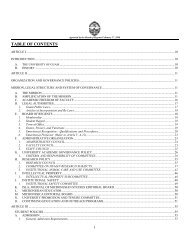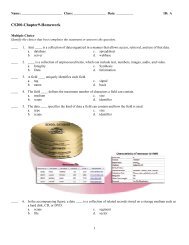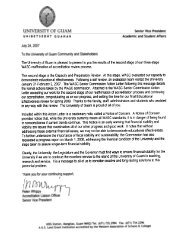Guam Business Resource Guide
Guam Business Resource Guide
Guam Business Resource Guide
You also want an ePaper? Increase the reach of your titles
YUMPU automatically turns print PDFs into web optimized ePapers that Google loves.
9.1 BASICS<br />
The U.S. government is the world's largest buyer of<br />
products and services. Purchases by military and<br />
civilian installations amount to nearly $200 billion a<br />
year, and include everything from complex space<br />
vehicles to janitorial services to cancer research. In<br />
short, the government buys just about every category<br />
of commodity and service available. Learning<br />
how the Federal government buys, understanding<br />
the responsibilities of contractors and recognizing<br />
subcontracting and procurement opportunities are<br />
the first steps to navigating this complex world of<br />
contracting.<br />
The government applies standardized procedures<br />
by which to purchase goods and services from suppliers<br />
who meet certain qualifications. That is, the<br />
government does not purchase items or services in<br />
the way an individual household might. Instead,<br />
government contracting officials use<br />
procedures that conform to the Federal<br />
Acquisition Regulation (FAR), or in the<br />
case of NASA, the Department of Defense,<br />
the Department of Homeland<br />
Security and others, procedures that<br />
conform to the FAR and supplemental<br />
regulations specific to those agencies.<br />
The FAR is a standardized set of regulations<br />
used by all federal agencies in<br />
making purchases. It provides procedures<br />
for every step in the procurement<br />
process, from the time someone in the government<br />
discovers a need for a product or service<br />
to the time the purchase is complete. Agency specific<br />
supplemental regulations compliment the FAR<br />
however they do not contradict the FAR. The FAR<br />
can be accessed electronically at http://<br />
acquisition.gov/far.<br />
By law, federal agencies are required to establish<br />
contracting goals, such that 23% of all government<br />
buys are intended to go to small businesses. In addition,<br />
contract goals are established for womenowned<br />
businesses, small disadvantaged businesses,<br />
firms located in HUBZones and service disabled veteran-owned<br />
small businesses. These governmentwide<br />
goals are 5%, 5%, 3% and 3%, respectively.<br />
Even though these are mandated goals versus mandated<br />
results, they are important because federal<br />
agencies have a statutory obligation to reach-out<br />
and consider small businesses for procurement opportunities.<br />
It is up to you to market and match<br />
your business products and services to the buying<br />
needs of federal agencies.<br />
While federal procurement procedures may have a<br />
different set of rules and regulations, many of the<br />
same marketing techniques and strategies you already<br />
employ may work here. Use your common<br />
business sense. Some tips: Get to know the agency<br />
and understand the context in which your product<br />
or service could be used. Obtain available information<br />
on past awards, quantities, costs and awarders.<br />
You may conduct research on the federal marketplace<br />
by geographic area or products and services<br />
through the Federal Procurement Data System<br />
which is available on line at www.fpds.gov.<br />
Become known to potential purchasers and the end<br />
users they represent. Before going forward, take a<br />
moment to think about your company's<br />
products and services. Take a<br />
close look at your company and consider<br />
what the government will look<br />
for when considering your company<br />
for a contract award. Financial<br />
status, staff capabilities and track<br />
record are all areas of interest to<br />
the government.<br />
9.2 PREREQUISITES<br />
The U.S. Government is increasing<br />
the use of single entry portals for those seeking access<br />
to the federal marketplace. One very important<br />
portal is Central Contractor Registration<br />
(CCR). Your firm must be registered in CCR as a<br />
prerequisite to being awarded a contract with the<br />
federal government and more importantly, a current<br />
registration ensures your firm will be promptly<br />
paid upon the delivery and acceptance of the product<br />
or service you provided to the government.<br />
The first step to becoming registered in CCR is to<br />
register your company with Dun and Bradstreet<br />
(DNB) who will issue your firm a D-U-N-S number.<br />
If your firm is based in one of the U.S. Territories<br />
or possessions located in the Western Pacific, you<br />
must obtain your D-U-N-S number through DNB –<br />
Australia. DNB-Australia’s website is located at<br />
www.dnb.com/au. All other U.S. companies should<br />
obtain their D-U-N-S number through the domestic<br />
34





![Residence Hall Application Form [PDF]](https://img.yumpu.com/46340085/1/190x245/residence-hall-application-form-pdf.jpg?quality=85)
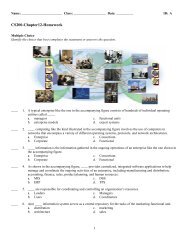

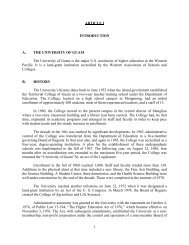
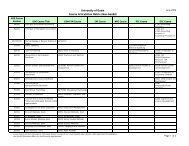
![Modern compiler design [PDF]](https://img.yumpu.com/37285279/1/190x245/modern-compiler-design-pdf.jpg?quality=85)


